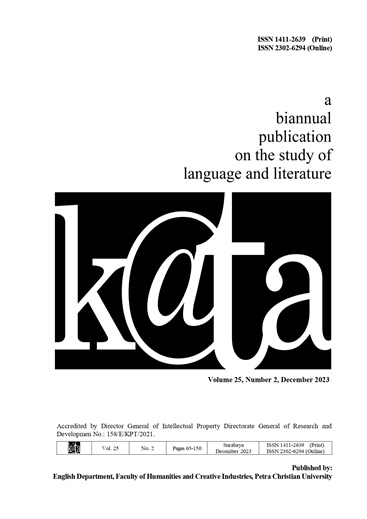The Dark and Dry Well: Hidden Psychotic Disorders in Murakami Haruki’s Novel
Abstract
The personal secrets of humans are just as though a deep and dark well. The peculiarities that occur within human beings not only attract numerous psychiatrists to unravel them but also captivate a Japanese writer, Haruki Murakami. In his novel entitled The Wind-Up Bird Chronicle, he conveys subjective experiences through his main character. The novel tells the story of Toru Okada’s subconscious journey. It is where human memories connect with various ancient subconscious thoughts, strange illusions appear, and unheard voices manifest to ordinary humans. These are common indications of schizophrenia symptoms. The research reveals the challenge in identifying this syndrome, as affected individuals become detached from the “true reality.” Consequently, a more structured approach is deemed necessary to facilitate their reintegration. With the assistance of mythology, wherein this narrative serves as a collectively recognized storyline, those trapped within their fantastical worlds can effectively communicate and establish connections with those residing in the “true reality.
Downloads
References
Anupama, A. (2022). Spiritual liberation in simulated societies: A study of inner consciousness in the select works of Haruki Murakami [Doctoral dissertation, Vimala College]. Institutional Repository University of Calicut Libraries. http://scholar.uoc.ac.in/handle/20.500.12818/825
Aschebrock, Y., Gavey, N., McCreanor, T., & Tippett, L. (2003). Is the content of delusions and hallucinations important? Australasian Psychiatry, 11(3), 306-311. https://psycnet.apa.org/doi/10.1046/j.1440-1665.2003.00560.x
Bär, E. (1976). Archetypes and ideas: Jung and Kant. Philosophy Today, 20(2), 114-123. https://doi.org/10.5840/philto¬day19762024
Bourbonais, A. S. (2010). Schizophrenic collective consciousness as represented in contemporary drama and fiction [Doctoral dissertation, George Mason University]. Mason Archival Repository Service. https://hdl.handle.net/ 1920/5846
Cooper, R. (2020). Murakami’s Interviews: Collections of Haruki Murakami’s Interviews, Studies and Thoughts. (n.p.): Independently Published.
Dil, J. P. (2007). Murakami Haruki and the search for self-therapy [Doctoral dissertation, University of Canterbury]. University of Canterbury Research Repository. http://dx.doi.org/10.26021/4796
Garguilo, M. (2012). The Existentialist world of Murakami Haruki: A Reflection of postmodern Japanese Society [Honor Thesis, State University of New York at Albany]. Scholars Arcive State University of New York at Albany. https://scholarsarchive.library.albany.edu/honorscollege_eas/1
Henderson, J. L. (1981). Books: Alchemy revisited. Psychological Perspectives, 12(2), 199-204. https://doi.org/10.1080/ 00332928108408697
Jablensky, A. (2010). The diagnostic concept of schizophrenia: Its history, evolution, and future prospects. Dialogues in Clinical Neuroscience, 12(3), 271-287. https://doi.org/10.31887/DCNS.2010.12.3/ajablensky
Jung, C. G. (1968). The Archetypes and the Collective Unconscious (R.F.C. Hull, Trans.; 2nd ed.). New York: Routledge. https://doi.org/10.4324/9781315725642
Jung, C. G. (1969). The Concept of the Collective Unconscious. In R. Hull (Ed.), Volume 9/1 Collected Works of C. G. Jung, Volume 9 (Part 1) (pp. 42-53). Princeton: Princeton University Press. https://doi.org/10.1515/97814008 50969.42
Jung, C. G. (2015). Psychology of dementia praecox (Vol. 714). Princeton University Press.
Knapp, B. L. (1978). Anaïs/Artaud—Alchemy. Mosaic: A Journal for the Interdisciplinary Study of Literature, 11(2), 65-74. https://www.jstor.org/stable/24780316
Lapworth, A. (2023). Thinking the unconscious beyond the psychoanalytic subject: Simondon, Murakami, and the transductive forces of the transindividual. Social & Cultural Geography, 24(9), 1501-1518. https://doi.org/10.1080/ 14649365.2022.2073469
Lee, J. Y. (2019). Colorless Tsukuru Tazaki and his years of pilgrimage: Through a psychodynamic lens. American Journal of Psychiatry Residents’ Journal, 14(6), p. 8. https://doi.org/10.1176/appi.ajp-rj.2019.140605
Loughman, C. (1997). No place I was meant to be: Contemporary Japan in the short fiction of Haruki Murakami. World Literature Today, 71(1), 87-94. https://doi.org/10.2307/40152571
Murakami, H. (1994). Nejimakidori kuronikuru (Dai 2 bu) Yogen suru tori hen [The Wind-up Bird Chronicle Part 2: Predicting Bird] Tokyo: Shinchōsha
Murakami, H. (1998). The Wind-up Bird Chronicle. New York: Vintage Books.
Murakami, H. (2019). Kronik Burung Pegas (The Wind-up Bird Chronicle).Jakarta.KPG
Nozaki, Y. (2002). Japanese politics and the history textbook controversy, 1982–2001. International Journal of Educational Research, 37(6-7), 603-622. https://doi.org/10.1016/S0883-0355(03)00053-3
Prabitha, P. (2023). Navigating the labyrinth: Unravelling psychological pepth in Haruki Murakami’s Kafka on the Shore and Norwegian Wood [Unpublised doctoral dissertation]. St. Mary’s College.
Rizzo, A. (2017). To the origins of psychosis: Study paths between clinic and culture. Mediterranean Journal of Clinical Psychology, 5(1), 1-3. https://doi.org/10.6092/2282-1619/2017.5.1526
Scatolin, H. G. (2015). Symbols of transformation: Preludes analysis of a schizophrenia (Summary of Volume 05, of Carl Gustav Jung Book). Psychology Research, 5(2), 148-151. https://doi.org/10.17265/2159-5542/2015.02.007
Silverstein, S. M. (2014). Jung’s views on causes and treatments of schizophrenia in light of current trends in cognitive neuroscience and psychotherapy research I. Aetiology and phenomenology. Journal of Analytical Psycho-logy, 59(1), 98-129. https://doi.org/10.1111/1468-5922.12057
Sinott, R., et al. (2016). What do bizarre delusions mean in schizophrenia? Psychosis, 8(3), 270-276. http://dx.doi.org/10.1080/17522439.2015.1100668
Strecher, M. C. (2014). The forbidden worlds of Haruki Murakami. Minneapolis: University of Minnesota Press. https://doi.org/10.5749/minnesota/9780816691968.001.0001
Strecher, M. C. (2020, July). Out of the (B) earth canal: the mythic journey in Murakami Haruki. Japan Forum, 32(3), 338-360. https://doi.org/10.1080/09555803.2019.1691628
Strecher, M. C. (2022). The Layered everyspace in the fiction of Murakami Haruki: Into the fantastical spaces of contemporary Japanese literature. Lanham: Rowman & Littlefield
Treat, J. W. (2013) Murakami Haruki and the cultural materialism of multiple personality disorder. Japan Forum, 25(1), 87-111. https://doi.org/10.1080/09555803.2012.741142
Wray, John. (2020). Semesta Murakami (D Martina, Trans.). Yogyakarta: Odyssee Publising.

This work is licensed under a Creative Commons Attribution 4.0 International License.
This work is licensed under a Creative Commons Attribution License


















